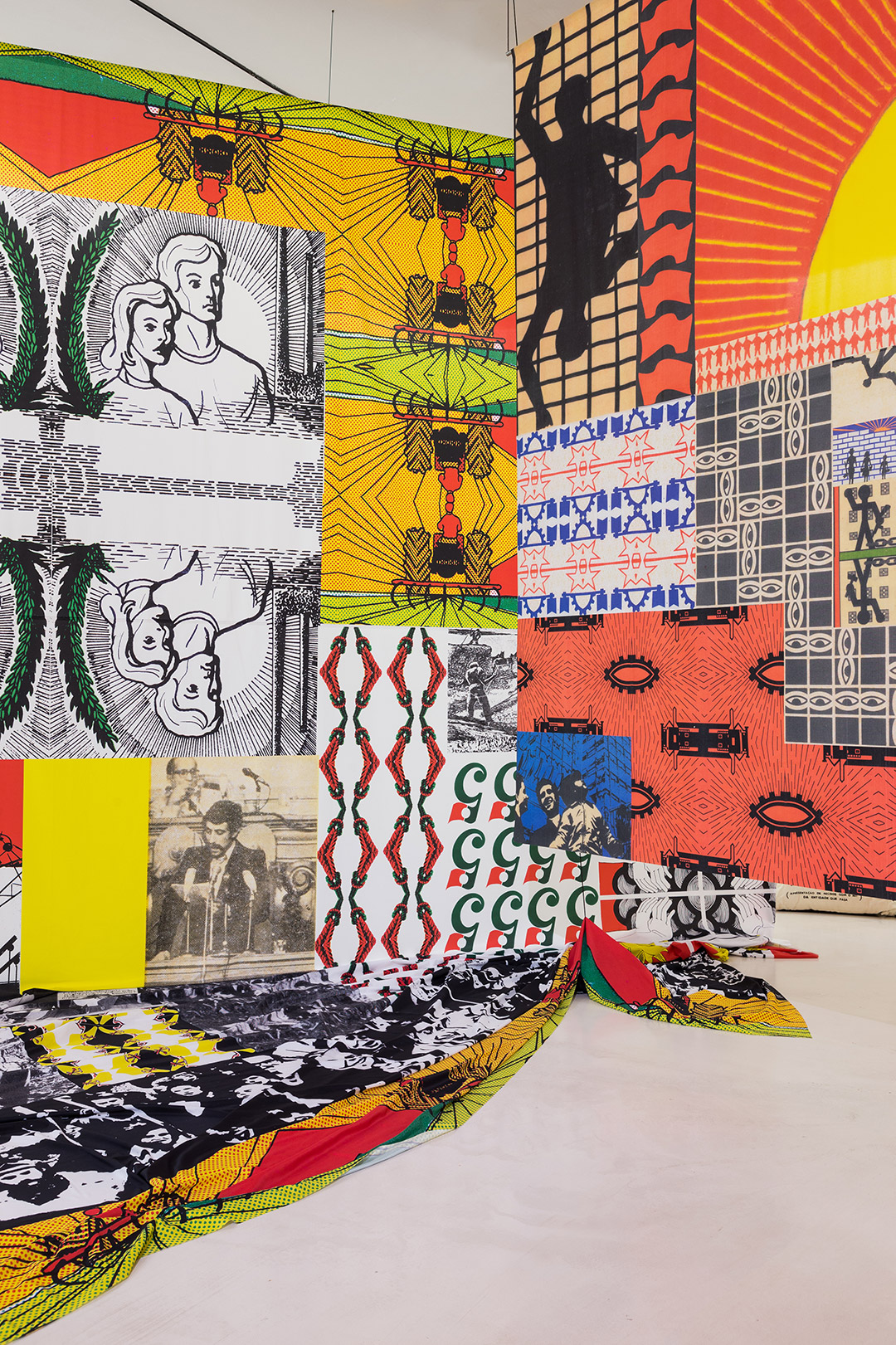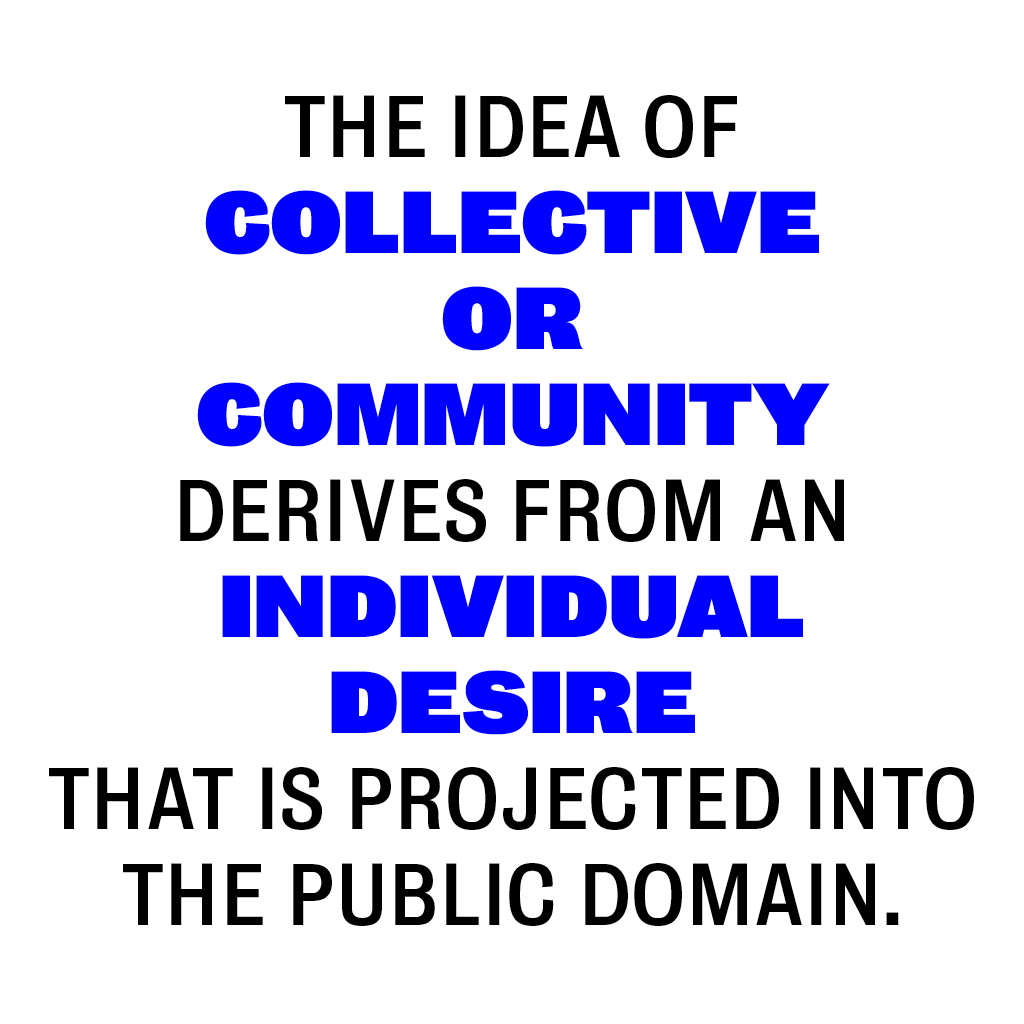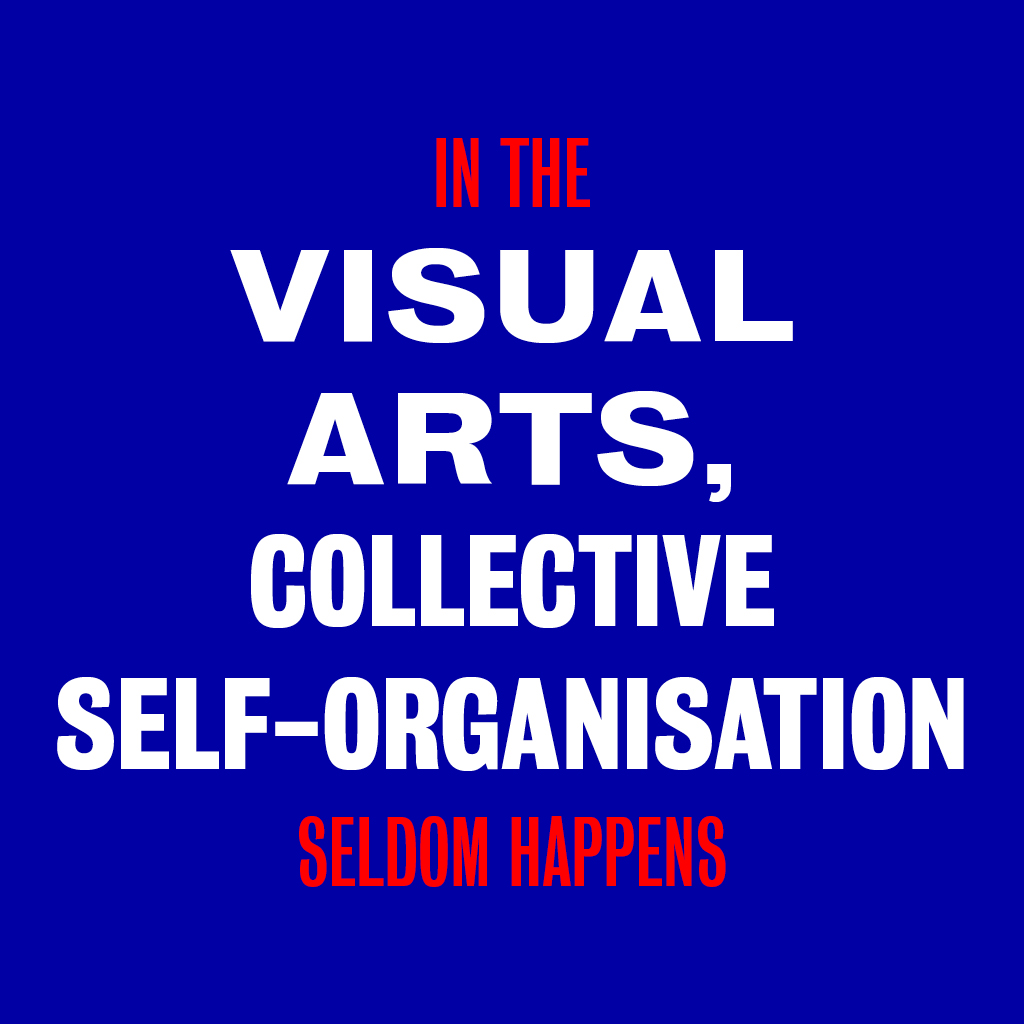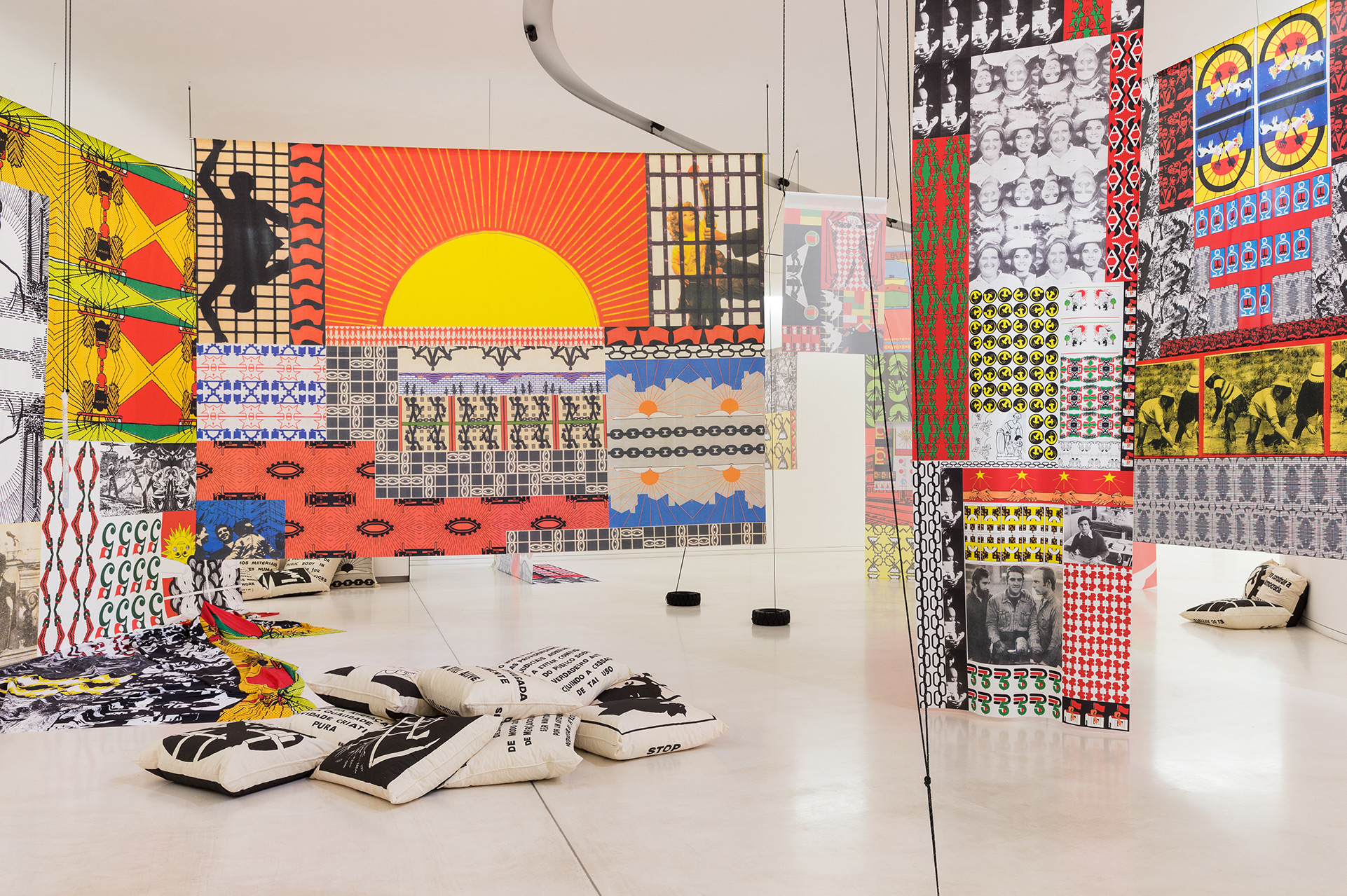Tomorrow there is no art
Carla Filipe in conversation with João Mourão and Luís Silva
This interview was originally published in 2019, in the catalogue of the exhibition Carla Filipe. Amanhã não há arte. Providing it with this new digital appearance comes from the realisation of the fragile situation that artists and other arts professionals are experiencing around the world. This weak condition was exacerbated by the pandemic, but it has long been identified.
João Mourão and Luís Silva
Let’s start by talking about the exhibition title: Amanhã não há arte [Tomorrow there is no art]. At first, it seems rather negative – a prediction of a bleak future, in which art and artists will have no place. But during our many conversations throughout the course of the development of this exhibition we began to think of this expression as a claim – it’s almost a cry for mobilisation and struggle. Not so much a destination, but an incitement to action. How did you decide on this title and why did you choose it to delineate the exhibition’s discursive field?
Carla Filipe
It’s not at all negative. On the contrary, it’s intended to remind artists of their power. The title Amanhã não há arte is linked to the protest slogans typically found on political posters. The future is never bleak, the future is open and built from possibilities that currently exist in the present. If artists say, “tomorrow there is no art”, the entire artistic structure will cease to exist, due to the absence of this core foundation – i.e. of the artistic objects that underpin the existence of institutions, galleries, etc.
Obviously, the title indicates an action, but it is not connected to any kind of organised collective group. It enhances the existence of this collective set of persons, but also highlights the absence of any specific group in the world of visual arts. A visual artist works individually, unlike in the performing arts, cinema or choreography. In the visual arts, collective self-organisation seldom happens. In recent years, a voluntaristic era has been implanted in the world of work, which aims to strip individuals of their rights, and remove each person’s self-ownership. Artists cannot agree with a system based on voluntarism or they will be creating a fragility and, consequently, further reduce their rights and capacity to make demands.

View of the exhibition “Carla Filipe. Amanhã não há arte” (maat, 2019). Photo by Bruno Lopes. Courtesy of the EDP Foundation.
João Mourão and Luís Silva
Your answer addresses several important issues which, to a certain extent, are the pillars that politically and formally underpin the exhibition. We’d like to discuss them with you in greater detail.
Let’s begin with the idea that artists are the labour force that sustains an entire system, which uses them to accumulate (cultural and economic) capital. The consequences of the disappearance of the artist, as you seem to suggest, are close to the consequences of a strike. Do you think that a strike by artists is a legitimate and relevant tool to campaign for their rights? If we talk about a strike we’re invariably talking about trade unionism and the strength of the collective. Do you think we need a trade union for visual artists?
Carla Filipe
Yes, if there were an act of protest on behalf of artists there would be positive consequences, but there is an urgent need to create a serious and well-organised entity to represent, protect and inform artists.
Academic teaching is completely set apart from the real world. For example, I never had any courses on copyright law, or was taught how to draw up a technical credits list or other objective issues related to the brass tacks of working in the professional world. We can only count on an oral undertaking, which is an agreement between two parties, a commitment of trust, but which is also very fragile. Obviously, in my career I have good examples of people keeping their word and commitments, and when this happens it’s extremely supportive – we can focus on our work and that’s how things should be. On the other hand, if this is not the norm, if it only occurs on rare occasions, it’s important to have a trade union or another form of representation, as in other countries.
But don’t forget, an act of protest doesn’t mean that the artist disappears from the scene. Artists never disappear, because they are driven by desire, pleasure and curiosity. Artistic thinking will always be eternal, unlike the art market. These two things are quite distinct: an act of protest consists of artists not producing their work, due to lack of respect and an ethical breach of their rights.
Artists never disappear, because they are driven by desire, pleasure and curiosity. Artistic thinking will always be eternal, unlike the art market.
Carla Filipe
João Mourão and Luís Silva
You mentioned education should play a core role in developing legal and fiscal literacy, which would be the basis for defending artists’ rights. It’s important for an artist to be aware of their rights, and the tools that one can use to ensure that one isn’t exploited. But it can also be argued that – as in any other profession or field of activity – these tools are acquired through exercising the profession, which is why it falls within the domain of experience, rather than education. The key question concerns a mechanism that can regulate or even self-regulate the professional activity (an association, professional order or similar body, as exists in many professions) that would ensure that artists’ rights are always safeguarded. While the argument of education places the responsibility for safeguarding rights on the individual, for these practical aspects, the concept of regulation transfers this responsibility to a structure which in principle has a higher capacity for action.

Detail of the exhibition “Carla Filipe. Amanhã não há arte” (maat, 2019). Photo by Bruno Lopes. Courtesy of the EDP Foundation.
Carla Filipe
One thing doesn’t invalidate the other. It’s important to include a course on copyright law in the academic curriculum. If authors are better informed, they will be more protected, but this doesn’t invalidate the existence of an entity that represents them. I can give you a practical example: try asking several artists for a draft certificate of authenticity. Each person will give you a different draft version and others will never have even heard of it. I managed to get hold of a fairly credible and complete model, from someone who works in the field of museology.
As an artist, in addition to my practice, I’m involved in many other tasks, ranging from production, managing teams, writing texts, bureaucracy, accounting, etc. I am involved in the entire process related to putting on an exhibition, and must be attentive to the many pitfalls that may arise along the way. The artist must be less involved in these tasks in order to focus on his work. I think only artists can understand the “Time and Place” of artistic creation. Above all, the key issue is to ensure respect for authors, by keeping one’s word, and not deceive or diminish them. Unfortunately, this often happens in certain contexts.

Images: graphic design by Márcia Novais.
João Mourão and Luís Silva
This exhibition deals to a certain extent with all these questions – which seem to be external to artistic practices but in general have a decisive influence on artists’ approaches to their creative processes. In “Tomorrow there is no art” you return to the visual and graphic strategies employed in political discourses, through careful analysis and recontextualisation of the associated communication materials, more specifically, the protest poster. You choose the form of the flag to embody a complex set of large-scale compositions in which repetitions and variations of the initial elements, collected from graphic materials associated with the political claims of Portugal’s recent history, surreptitiously divert and contradict, sometimes in an antagonistic manner, their own origin and identity. What is your relationship with these materials and how do you think they are relevant, from a contemporary perspective, to talk about the (precarious) place occupied by the artist?

Carla Filipe
Yes, these issues seem to lie outside artistic practices, but they constitute an intrinsic part of the artist’s life. This theme appears repeatedly in the artistic medium, in the form of conversations, but is never included in the work. It’s almost as if we denied its importance, as if it were taboo.
Since 2009 I have spent several periods of time developing works about trade unions, the role of the community and the collective, as well as the absence thereof, using my archives, which essentially consist of political posters from the period after the 1974 revolution. For this exhibition I will be using the graphic elements of these posters in another way, through construction of patterns, repetitions, mirroring, obtaining complex compositions that lose their reference and which point towards another, abstract and figurative, universe. The process is the metric that defines the composition of these fabrics: destruction of the referent, camouflage, mirror, abstraction, repetition and an extreme sense of composition of the images that does not foresee the end result.
“Tomorrow there is no art” presents flags of various sizes – some on a small, human scale, that suggest an enticing idea of an inhabited space (house), accompanied by cushions that encourage the body to relax. These flags have a sculptural composition, facilitated by the flag hoisting and counterweight system, using tyres. This is an improvised engineering system, a common feature of everyday life, in the construction of devices to remedy an initially temporary situation that becomes permanent. This system, created by using tyres, rope and pulleys, makes it easier to hoist the flags, was developed through a system that was built in my own studio, making it easier to dominate the architectural space. There are also large flags that extend down to the floor, with folds that omit parts of the drawing referring to utopias and which manifest the desire for transformation of society in this post-revolutionary period.
I pursue this new approach to the archive, related to political posters, without the presence of the manufacturing process, as took place in my previous works. I assembled the images, using collage or painting. I initially sewed the flags myself, but soon started working with seamstresses and for this reason the flags were made in flag shops, with direct application of embroidery and sewing, which is an increasingly rare activity. The approach I developed for maat is, in turn, linked to stamping the fabric, providing a more real reproduction of this archive, revealing its graphic quality by the large-scale enlargement of the images, as well as the marks left by time and the corresponding degradation. No questions whatsoever were raised during the production of these compositions. In the midst of this wealth of patterns, that which still suggests the idea of flag is the existence of isolated images, some of which are related to ordinary people, the elderly, women, men, and a great deal to children and young people. The child is a recurring image in these posters, since it alludes to new life. The child as a symbol of hope for a better future, with the right to health and education.
These flags or fabrics do not raise any questions. They are passive images, a mirror of society. But perhaps visitors may reactivate these images. For example, a visitor might recognise himself in the flags, his or her portrait as a child, or might recognise some of the symbols or graphics used in the patterns, awakening a collective memory and prompting discussion or a spontaneous conversation within the exhibition space, because it establishes links with the universe of people. Everyone has an opinion, their own personal story. In parallel with the flags versus fabric/patterns with history, there are cushions on the floor – the space that raises questions about the author’s “precariousness”. The artist can lie down on these cushions, with his or her face resting on the article related to copyright, or sentences by Robert Smithson and Theodor Adorno and other authors, accompanied by an informative newspaper with free distribution. We have two poles in the exhibition: one from the ceiling, more floating, the other from the floor, more reflective, directed to the artistic community.
Furthermore, in this collection of stickers there is a recurring phrase “The voice of the actor is the voice of the exploited”. We can replace the actor by the artist in this context. The artist’s voice cannot exclude itself, because this would be a contradiction.

João Mourão and Luís Silva
The place occupied by the cushions will also enable visitors to socialise, share and discuss ideas. These small “islands” of cushions will allow visitors to sit in a group. Exhibitions are increasingly individual experiences, in the sense that each person walks around and sees the works at their own pace. And any discussions take place outside the exhibition space. It seems to us that you are trying to reverse this tendency – by creating spaces where people can sit down, read a newspaper, talk and exchange ideas. Are you trying to create the possibility of such encounters in the exhibition?
Carla Filipe
Yes. A museum can and should be a meeting place, for the spontaneous exchange of ideas, without this necessarily being linked to a programme. These islands of cushions suggest the idea of a public space, enabling strangers to become acquainted.
João Mourão and Luís Silva
Let’s get back to an idea that you mentioned earlier: that you have repeatedly developed works about trade unions and the role played by the collective and the community in our lives. Let’s also return to what you mentioned in your previous answer, the creation of the possibility to become acquainted with strangers. What space still exists, in an increasingly individualistic society, for such meetings and for the creation of the collective? What role do you think contemporary art can play in the development of a public sphere?
Carla Filipe
Art can play this role of creating a public sphere, but it shouldn’t alter its language in order to draw closer to the public. Art must have autonomy and critical power and offer new aesthetic experiences rather than serve the need to build a general understanding of things for the masses, which is the place of the language of propaganda or of the “culture industry”. The latter has occupied a more affirmative role, effectively neutralising artistic and critical thinking, and fostering a passive vision. These issues were addressed by Adorno and Horkheimer over 50 years ago – if art occupies a passive and uncritical place, without generating new aesthetic experiences, there is no rupture, restlessness or conflict.
Yes, today’s society is indeed more individualistic, more alienated or dispersed. I have a social commitment, but this isn’t rational – I don’t know whether this comes from my education, I can’t remember – but this "commitment" is a very intimate part of me, probably came from the political stickers, that covered the public spaces in the 1970s and 80s. As a child I was always very sensitive to issues of discrimination against minorities, social classes, etc. That shaped my personality. It’s very difficult to counteract this influence. The idea of community or collective isn’t linear, it’s very complex, organic or spontaneous. I have reached the conclusion that the idea of the collective or community derives from an individual desire that is projected into the public domain. Desire leads us to movement, action, reflections, reactions, transformation. Some of my installations harbour this desire to build a community – I create a space which invites people to socialise. I play with the visual component related to political issues, but there is also poetry. The visual arts have their own language and discourse, which includes space versus architecture, that is entirely linked to the individual. As with poetry, art isn’t just content. Words are part of a communication process between people. They are signs, but in poetry – words and structures are used in a different manner, opening up the aesthetic field.
João Mourão and Luís Silva
You claim that in your work you play a great deal with the relationship between the visual component and politics. In this case, there is a very specific origin of the images you use. Would you like to tell us a little about where these images come from?


Views of the exhibition “Carla Filipe. Amanhã não há arte” (maat, 2019). Photos by Bruno Lopes. Courtesy of the EDP Foundation.
Carla Filipe
The images I have used in this exhibition are details from political posters, stickers from political parties, cultural associations or commemorative dates, with no connection to any party. They portray part of Portugal’s political history, after the 1974 revolution, the period of PREC (→ 1) and the following years. They belong to the archive that I’ve put together over the years.
The sticker was the most commonly used format in this period, and it manifests identity, a visual explosion with various graphic languages, that contrast with the uniform visual propaganda of the Salazar regime. This collection of stickers reveals many influences: some are authorial, others psychedelic, others have a childlike design, or were even conceived by children, in others there is a clear influence of Russian constructivism, and we have some with a very marked design, clearly delineating a mark/identity. In the post-revolutionary period, there was a rupture, accompanied by a graphic explosion that was linked to political and social manifestations. This also gives us a more conscious view of the manifestations of the period, some of which continue to be relevant, but today the sense of community is diluted. The exhibition represents this dilution.
-
(1) Processo Revolucionário em Curso [Ongoing Revolutionary Process] was the period during the Portuguese transition to democracy, which started after a failed right-wing coup d'état on 11 March 1975, and ended after a failed left-wing coup d'état on 25 November 1975.
João Mourão and Luís Silva
We have a question that is essentially visual and is perhaps more complicated: if you had to draw a couple of stickers to convey the ideas that we are developing in this exhibition, ideas associated with an artist’s collective, a movement based on protests and reaction, what would they be?
Carla Filipe
It’s difficult to give an exact and decisive answer, because I develop my thinking in the visual arts; I’m very interested in the territory of contemporary art as a privileged space for experimentation, of plurality, in which various disciplines can cohabit the same place, contrary to unilateral thinking. That makes it very difficult to answer your question.
We have the exhibition, although temporary, we have the book and the newspaper – which are reflective, informative and aesthetic documents that will endure over time and contaminate each other.
If I were to produce stickers — which use a direct, affirmative and conclusive language I would probably use phrases from my historical archive of the period after the 1974 revolution, and update them, such as “The cultural revolution belongs to the artist”, “Art and culture at the service of the people's struggle”, “The people don’t fight, art doesn’t serve" and, of course, “Tomorrow there’s no art”.
The cultural revolution belongs to the artist. |
|
|
|
The people don’t fight, art doesn’t serve |
The exhibition Amanhã não há arte (maat, 2019) continued Carla Filipe’s research into the visual and graphic strategies used in the political narrative – specifically protest banners – this time to question the role of the artist in the socio-political context. Deprived of individual protesting capacity and without the power of a collective body to support her, the artist issues the threat: “Tomorrow there’s no art”, as an attempt to mobilise people to react to the challenges faced by the artistic community.
-
Get the book here.
Carla Filipe (b. 1973) lives and works in Porto, where she cofounded Salão Olímpico (2003-2005) and O Projecto Apêndice (2006), two artist-run spaces. In 2010, Carla participated in Manifesta 8, curated by tranzit.org, in Murcia and Cartagena, Spain. In 2015, she was a resident at Robert Rauschenberg Foundation (Captiva, Florida, 2015) and, in 2017, at Krinzinger Projekte (Vienna, 2017). “Yesterday died today, today will die tomorrow” was a project she curated with Ulrich Loock, for the Galeria Municipal do Porto (2018). In 2014, the Museu Coleção Berardo and Archive Books published her first monograph on the occasion of the exhibition “da cauda à cabeça” (2014).




